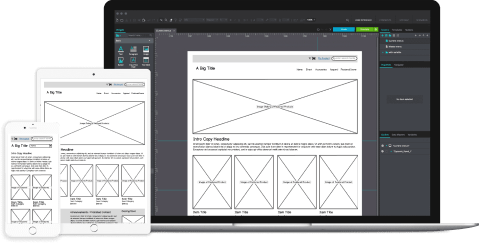Custom Software Process and Strategy (Step 1)
Every successful custom software development project starts with the right approach to process and strategy.
Most enterprise-sized, Fortune 1000 companies will have an annual budget for software. There’s always great debate about whether that budget is adequate or being invested in the right places.
However mid-market companies are entirely different in that they typically only budget for using software — not creating their own software. As a result, mid-market companies are often not building the kind of software tools and platforms that they need for improving business processes, addressing challenges, achieving their goals, lowering costs, empowering employees, remaining competitive, and driving revenue growth.
While some companies are well-served by commercial, canned, off-the-shelf, software as a service (SaaS) offerings, mid-market companies are often frustrated by the inability of packaged software to address their unique business challenges.
Mid-market companies at this stage reach the point where their leaders realize that custom software makes way more financial sense for them.
However, starting on this kind of initiative can be scary. You wonder for example, how much will custom software development cost? Platitudes and non-answers such as, “between $10,000 and $500,000” simply won’t cut it.
Mid-market business leaders must know what kind of investments they’re looking at, so they can accurately plan ahead based on a guaranteed budget. And that’s the reason why the approach to process and strategy is so important.

Why?
In a digital-first world, most companies realize that they need sound, forward-thinking IT investments to remain competitive. In the not so recent past, IT was all about empowering employees with desktop productivity software, file sharing, print sharing, and email. However, today’s buyers – influencers and decision makers – demand so much more from companies of all sizes and across all industries.
Your customers and other relevant stakeholders have grown accustomed to, and in many cases feel entitled to, the same technology conveniences that they enjoy from their smartphone and key disruptors like Amazon, Airbnb, Netflix, and Uber. Is your company prepared to confront these marketplace realities? Or will it bury its heads in the sand and act as if mobile devices, search engines, social media, and cloud computing were never invented?
With 224 million smartphone users in the United States (which is nearly 70% of the U.S. population), companies that want to remain relevant need to get out in front of these trends and innovate – before it’s too late. To stay competitive, companies now invest a record $439 billion worldwide into enterprise software.
However many of these same companies are often massively dissatisfied with existing off-the-shelf, canned Software as a Service (SaaS) offerings. Instead, companies choose to develop their own custom software technology that addresses their own company’s unique challenges, helps achieve their business goals, drives more revenue, and reduces costs.
Step 1: Exploratory Call, Online Meeting, or Face-to-Face Meeting
- Cost: Free
For a company that’s exploring whether a custom software development project makes sense, this initial Exploratory Meeting reviews needs, problems, challenges, and the overriding business goal to be optimized.
During the Exploratory Meeting, you’ll learn about how other companies similar to yours use custom software to solve meaningful business problems and whether it makes sense to take the next step with a Discovery Consultation.
Book Time on the Calendar for Your Free Exploratory Meeting
- Free 30 Minute Process Improvement Consultation.
- Free 30 Minute HR Digital Transformation Consultation.
Step 2: Discovery Consultation
- Cost: $950
- Deliverable: Summary of Findings Report
The Discovery Consultation generally takes place at the client’s location with the key stakeholders who know the related processes. During this consultation, a business analyst works with the client to discover how existing systems are utilized and explore the potential for optimizing systems and processes.
This step of the process is all about the client’s business model and understanding the current limitations and frustrations. A Discovery Consultation is not centered around software, technologies, or platforms. Those are all addressed later after business objectives are nailed down.
At the conclusion of the Discovery Consultation, you’ll receive the Summary of Findings Report, learn whether your company is a good fit for a custom software development project, and learn if your company is at the stage where Prototyping and Wireframing make for a sound financial investment. The goal is to discover business flows and processes that can be optimized to solve problems, increase quality, and save time and money.
Step 3: Requirements and Visualization
- Cost: Typical costs range from $5,000 to $25,000 depending on the project
- Deliverable: Prototype and Wireframe
During Requirements and Visualization, there’s an intense focus on building and validating the prototype of the future custom software product.
In Step 3, the client signs the contract which includes the business requirements document (BRD), the timeline, the budget, the payment terms, and warrant. The project manager and business analyst work together to plan the project.
By investing time and resources upfront into Requirements and Visualization, generally 10% to 15% of a project, both the client and custom software development firm dramatically increase the opportunity for a successful outcome. Why?
When you better define the precise requirements and scope during the Requirements and Visualization phase, both parties know exactly what’s being built and how the system will function – before investing in custom software development.
At this point, the focus is on how to replicate a business process. So there will be considerable attention centered on the user interface (UI) and the user experience (UX) – the visuals, or look and feel, of the future system and the logic of how the application will work.
Once the prototype is created, clients experience that “aha” moment – the instant when the solution to their business problems starts to become more clear and concrete. Clients can log in to the system and see the capabilities.
The key for a successful Requirements and Visualization outcome centers around cooperation and buy-in: Clients need the right subject matter experts (SMEs) and representative users participating in planning sessions and testing the prototype.

By the end of the Requirements and Visualization phase, clients will have a functioning prototype of their future system. Clients also get a Business Requirements Document (BRD) which explains the prototype and contains rules and dependencies. And just as important, once the prototype is approved clients will understand the exact, guaranteed budget required to move forward with their custom software development investment.
Step 4: Custom Software Development
- Cost: To be determined after Step 3: Requirements and Visualization
- Deliverable: Custom software in the form of website application development, mobile application development, custom API development, front-end development, or content management system (CMS) development.
Once the Exploratory Meeting, Discovery Consultation, and Requirements and Visualization phases are complete, the client is now ready to move onto the actual custom software development. Human resources are allocated at Step 4.
Because of the step-by-step process, the client is much happier. The client has seen, tested, and approved a fully-functioning prototype. The software development team is much happier as well because the scope and requirements have been so much more clearly defined.
And just as important, the client is relieved of one major worry. There will be no surprises on costs. There’s a guaranteed budget.
In the final step of the process and strategy building, to get the company to a state where its new custom software can improve business processes, address challenges, achieve their goals, lower costs, empower employees, remain competitive, and drive revenue growth, there are three main parts.